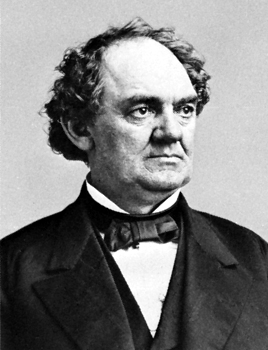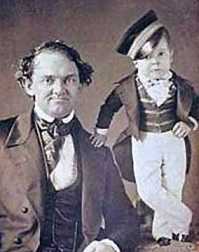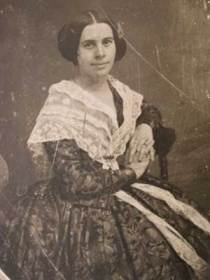Fun Facts about P.T. Barnum
-

John O'Neill, of the Bethel Land Trust, stands near Ivy Island in Bethel, which was once owned by PT Barnum
Phineas Taylor Barnum was born in Bethel, Connecticut in 1810.
- Speaking of his youth, P. T. Barnum said, “I was always ready to concoct fun, or lay plans for moneymaking, but hard work was decidedly not in my line.” Indeed, he succeeded in making a great deal of money by working hard at having fun.
- When he was born, his grandfather deeded him a parcel of land known as lvy Island. The growing boy was constantly reminded of his property. When he was 10 years old, he went to visit his estate and discovered it to be “a worthless piece of barren land.”
- When Phineas was 15, his father died, leaving his widow and five children penniless. Phineas immediately became clerk in a country store, where he learned the fine art of Yankee trading. During the next 10 years he was a shop owner, director of lotteries, and newspaper publisher.
- When he was 19 he eloped with a local seamstress, Charity Hallett (who would remain his wife for 44 years and give him four daughters).
- At 22, as publisher of the Herald of Freedom, he was jailed for libelously accusing a deacon of usury; upon his release 60 days later, Barnum was met by a band and “a coach drawn by six horses” for a parade back to town.
-
He made his first sensation in 1835 when he met Joice Heth, a slave who claimed she was 161 years old (she was about 80) and had been the nurse of George Washington.
- Seeing Joice Heth’s possibilities as a human curiosity, Barnum purchased the right to exhibit her, along with the documents validating her age, and set her upon her couch in Niblo’s Garden in New York City. She was extremely popular, but when interest began to flag, a newspaper item appeared suggesting that Joice was not human at all but an “automaton” made of whalebone, indian rubber, and springs.
- Shortly after the article was published, the exhibition hall was full once more, for Barnum always knew how to use the news as well as the advertising sections of newspapers. Finally, upon her death in 1836, when an autopsy proved that Joice had been no more than 80 years old, Barnum was as surprised and indignant as anyone else. He had learned, however, that “the public appears disposed to be amused even when they are conscious of being deceived.”
- For the next four years Barnum was an itinerant showman in the West and South. By 1840 he was back in New York, poor, weary of travel, and without prospects.
-
When he heard that the struggling Scudder’s American Museum (with its collection of curiosities) was for sale, Barnum determined to buy it. “With what?” asked a friend. “Brass, ” Barnum replied, “for silver and gold I have none.” He mortgaged himself to the building’s owner, proposing for collateral good references, a determination to succeed, and a “valuable and sentimental” piece of property known as Ivy Island.
- In 1842 he opened the American Museum in New York City and immediately became famous for his extravagant advertising and his exhibits of freaks.
- By the end of 1842 the museum was his, and a year later he was out of debt.
- Barnum’s American Museum was to become the most famous showplace of the century. Here, in constantly changing and elaborately advertised parade, the public could see educated dogs and fleas, automatons, jugglers, ventriloquists, living statuary, albinos, obese men, bearded women, a great variety of singing and dancing acts, models of Paris and Jerusalem, dioramas of the Creation and the Deluge, glassblowing, knitting machines, African Americans performing a war dance, conjoined twins, flower and bird shows, whales, mermaids, virtuous melodramas such as The Drunkard, a menagerie of rare animals, and an aquarium—”all for twenty-five cents, children half price.”
-
His Great Model of Niagara Falls with Real Water was actually 18 inches high; the Feejee Mermaid was really a monkey’s head and torso fused to a fish’s tail; the Woolly Horse of the Frozen Rockies had in truth been foaled in Indiana.
- Only half in jest did Barnum seek to buy Shakespeare’s birthplace, hire the Zulu leader who had recently ambushed a British force, and tow an iceberg into New York harbor. Altogether, the museum showed over 600, 000 exhibits during its existence.
- Among his great attractions were the aforementioned Feejee Mermaid, “General Tom Thumb,” who was viewed by over 20 million people, and the original Siamese Twins, Chang and Eng.
-
General Tom Thumb was Barnum’s greatest attraction. Charles S. Stratton, a native of Bridgeport, Conn., was 25 inches tall and weighed 15 pounds when he entered Barnum’s employ in 1842. When he died in 1883, at the age of 45, he had made millions of dollars and delighted international audiences.
- In the first of Barnum’s many European junkets the General entertained Queen Victoria, King Louis Philippe, and other royalty with his songs, dances, and impersonations in miniature. Of the 82 million tickets Barnum sold during his lifetime for various attractions, Tom Thumb sold over 20 million.
- In 1850, Barnum managed the American tour of the Swedish singer Jenny Lind and, with his talent for publicity, made it a huge financial success for her and for himself.
-
The immensely profitable tour of this gracious “Swedish Nightingale” was prepared with ingenious public relations but conducted with dignity and generosity by Barnum. Its success initiated the vogue of European concert artists visiting the United States.
- In 1855 he retired from show business; he served as mayor of Bridgeport, Conn., and in the Connecticut legislature.
- In 1857 his famous house, Iranistan, fashioned after George IV’s Pavilion at Brighton, burned to the ground.
- The original museum burned in 1865, and new museums burned in 1868 and again in 1872.
 The showman’s greatest financial catastrophe had nothing to do with show business. For years he had cherished the dream of building a city out of the farmland of East Bridgeport—a benevolent endeavor, he thought. In order to attract business, he signed some notes guaranteeing the debts of the Jerome Clock Company. As a result, he lost all he owned. Thus, in 1855, at the age of 46, the great Barnum was bankrupt.
The showman’s greatest financial catastrophe had nothing to do with show business. For years he had cherished the dream of building a city out of the farmland of East Bridgeport—a benevolent endeavor, he thought. In order to attract business, he signed some notes guaranteeing the debts of the Jerome Clock Company. As a result, he lost all he owned. Thus, in 1855, at the age of 46, the great Barnum was bankrupt.-
He worked his way back from bankruptcy, however, in part from successful lectures on “The Art of Money Getting, ” and by 1860 he was free of debt once more.
- Throughout his life Barnum was a political liberal, serving in the Connecticut Legislature in the late 1860s, where he diligently fought the railroad interests, and as mayor of Bridgeport in 1875-1876.
- A year after the death of his first wife, Charity, in 1873, Barnum married Nancy Fish, an English woman 40 years his junior.
- In April 1874 Barnum opened his Roman Hippodrome in New York; this was to grow into the great circus. While he did not invent the circus, an ancient form of entertainment, he made it a three-ring extravaganza the likes of which had never been seen before.
- In 1881 he merged with his most successful competitor, James A. Bailey, and under the name Barnum and Bailey the circus continued for a generation after Barnum’s death.
-
In what was described as “Barnum’s last great coup” he purchased Jumbo, the 61⁄2-ton African elephant (and largest elephant kept in captivity), from the London Zoo despite the furious protests of English elephant fanciers, including Queen Victoria.
- Violent objections by the English only made Jumbo and the circus that much more appealing.
- In 1882 the circus opened its season in Madison Square Garden, where it was to become an American institution; and everywhere the “big top” traveled, a “Barnum Day” was declared. Circling the arena in an open carriage as leader of the parade always brought roars of approval (and great satisfaction) to the aging genius.
- In 1887, the great circus in its winter quarters, with most of its menagerie, was lost to fire, yet it somehow managed to continue on.
- By 1891 Barnum’s body began to fail, though not his spirit. His child’s delight in the joke, the curious, and the splendid had set an entire nation to wondering and laughing and buying.
- A few weeks before his death, Barnum gave permission to the Evening Sun to print his obituary, so that he might have a chance to read it. On April 7 he asked about the box office receipts for the day; a few hours later, he was dead.
- His autobiography was published in 1855 and went through many editions.
- He also wrote Humbugs of the World (1865), Struggles and Triumphs (1869), and Money Getting (1883).
Special thanks to education.yahoo.com and www.encyclopedia.com







































 The Mind of Adam J. Kovitz
The Mind of Adam J. Kovitz